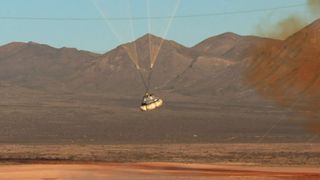Image 1 of 11

(Image credit: Boeing)
On Monday (Nov. 4), Boeing tested the emergency escape system of its CST-100 Starliner spacecraft in a pad abort test in the desert of New Mexico. It was uncrewed this time, but the spacecraft will soon begin launching astronauts to the International Space Station. See photos of the spacecraft's launch and landing in this gallery. Above, the Starliner capsule sits on top of the test stand at White Sands Missile Range.
Full Story: Boeing Tests Starliner Spacecraft's Launch Abort System for Rocket Emergencies
Image 2 of 11

(Image credit: Boeing)
Here, Boeing engineers prepare a CST-100 Starliner crew capsule for a critical pad abort test on Nov. 4, 2019 at the White Sands Missile Range in New Mexico.
The test vehicle was about 16.5 feet tall and included a Starliner crew capsule (top) and its cylindrical service module at bottom. The crew capsule returned to Earth under parachutes and airbags. The service module crashed into the New Mexico desert as planned.
Image 3 of 11

(Image credit: Boeing)
The CST-100 Starliner stands on top of its test stand on Launch Complex 32 at the White Sands Missile Range in New Mexico ahead of the pad abort test. Also attached to the bottom of the capsule is the service module, which supplies the spacecraft's power and propulsion systems.
Image 4 of 11

(Image credit: Boeing)
Here's another view of the Boeing's Starliner pad abort test article on the launch pad at the U.S. Army's White Sands Missile Range in New Mexico.
Image 5 of 11

(Image credit: Boeing/NASA JSC)
The CST-100 Starliner, with its service module attached, lifts off from Launch Complex 32 at White Sands Missile Range in New Mexico for the pad abort test. The launch occurred on Nov. 4 at 7:15 a.m. local time (9:15 a.m. EST, 1415 GMT).
Related: Boeing CST-100 Starliner: Next-Generation Spaceship
Image 6 of 11

(Image credit: Boeing/NASA JSC)
During the pad abort test, the CST-100 Starliner spacecraft reached a speed of about 650 mph (1,046 km/h) in just 5 seconds. If anything were to go wrong with the rocket during liftoff, this abort system would allow the astronauts on board to safely get away from the unstable rocket and float back down to Earth.
Image 7 of 11

(Image credit: Boeing/NASA JSC)
To safely return to Earth, the CST-100 Starliner spacecraft has three sets of parachutes: two drogue parachutes, three pilot parachutes and three main parachutes. Here, two of the three main parachutes have deployed successfully in the pad abort test. Boeing officials said there was a "deployment anomaly" with the third main parachute, but added that "having two of three deploy successfully is acceptable for the test parameters and crew safety."
Related: Parachute Development a Challenge for Commercial Crew
Image 8 of 11

(Image credit: Boeing/NASA JSC)
Airbags inflated under the spacecraft to cushion its landing. Although the CST-100 Starliner landed on dry land in New Mexico during the pad abort test, if the emergency abort system were activated during a real launch carrying astronauts from Kennedy Space Center, it would splash down in the Atlantic Ocean.
Related: Here's Why Boeing Used an Inflatable Spaceship to Test 'Starliner' Landing Recovery Plans
- Crew Dragon and Starliner: A Look at the Upcoming Astronaut Taxis
- NASA Rehearses Astronaut Launch and Rescue with SpaceX, Boeing (Photos)
- Boeing Astronaut Reveals Mission Patches for Starliner Flight Tests
Email Hanneke Weitering at hweitering@space.com or follow her @hannekescience. Follow us on Twitter @Spacedotcom and on Facebook.
